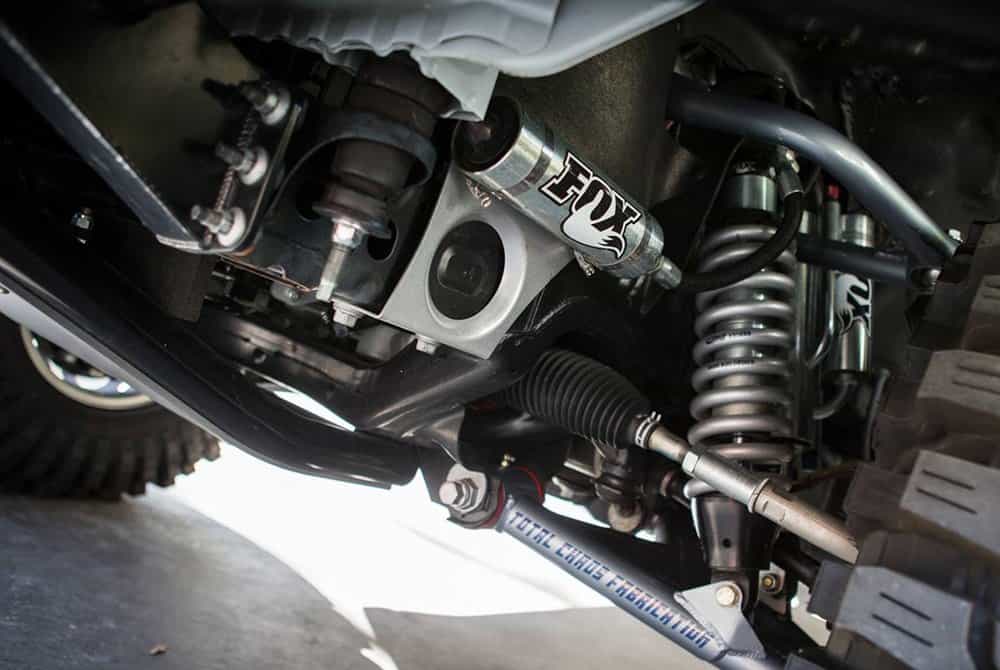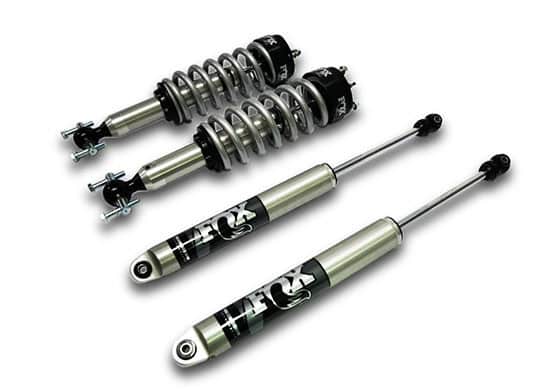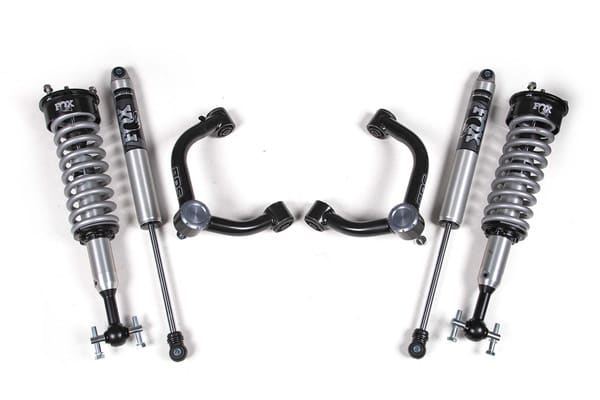Shock Service - Fox 2.0 Reservoir Rebuild
Posted by Sean Reyes on
To Service or Not to Service?
When people purchase brand new Fox shocks, they often ask us “how often do I need to service these shocks?” There’s no universal answer; brands like Fox and Icon recommend servicing at least every 50k miles, but that mileage varies depending on driver behavior.
- Going hard every weekend - 50k miles may be far too late.
- Daily driver with occasional easy dirt terrain - 40-50k miles is safe.
- Desert buggy that sees 1,000 miles over the season - probably needs a rebuild once a year.
How to Determine When Your Shocks Need Service
So there’s no universal answer as to when you should service these parts, it comes down to how much abuse they’ve seen. But then you may ask “how can I tell if my shocks need service?”
Things feeling more squishy than usual? More body roll? Hitting your bumpstops more often? Those are telltale signs of shocks not operating at 100%.
You can do a nitrogen gas pressure test at an off-road shop to see what the PSI is currently, vs what they were when freshly built.
You can clean the shock completely before a weekend, and on Sunday after the fun was had, see if there’s oil or fluid on the shock. This is a sign there are leaking seals.
When we refresh shocks like these, new seals go onto the seal head, new wiper seals are installed, and other internal O-rings get replaced. New oil is put in, and that oil quality varies depending if you want top of the line race oil, or a more standard type of oil with less friction (than race oil).
If you have any questions on the above, reach out to us and we’d be happy to help!
Fox 2.0 Reservoir Shock Rebuild Steps
- Release nitrogen and remove valve core
- Loosen set screw
- Unscrew wiper cap
- Remove seal head circlip
- Remove shaft from shock body
- Remove reservoir cap circlip
- Remove reservoir cap
- Dump out old shock oil
- Remove IFP
- Clean shock body & reservoir
- Change IFP seal
- Fill with shock oil
- Reinstall IFP into reservoir
- Disassemble shim stacks, piston and seal heads
- Replace old seals on seal head and wiper cap
- Clean and reinstalled wiper cap, seal head, shim stacks & piston
- Bleed air from shock
- Reinstall retaining circlips & seal shock
- Install valve core & charge with nitrogen
Fox Shock Rebuild: Revive Your Ride
Shock Surplus is your go-to for Fox shock service and Fox repair. Our skilled technicians offer top-notch Fox shocks rebuild, ensuring your suspension performs at its best. Trust us for quality Fox service and maintenance, because your ride deserves the best care.
For professional Fox shocks service and rebuilding, Shock Surplus is your destination. Discover affordable options with transparent cost to rebuild Fox shocks. Elevate your suspension performance by rebuilding Fox shocks and get back on the road with confidence. Find the lower Fox shock rebuild cost here.

Reviving Performance: Fox Shock Rebuild Service
If you're a serious off-roader, a motorsport enthusiast, or simply an individual who values the importance of a smooth and controlled ride, you're likely familiar with Fox Shocks. These high-quality suspension components are renowned for their durability and performance. However, like any mechanical part, they can wear down over time. This is where the Fox Shock Rebuild service comes into play, especially when it comes to the popular Fox 2.0 Performance Series shocks.
Fox 2.0 Shock Rebuild: Enhance Performance
At Shock Surplus, we offer top-tier solutions for Fox 2.0 rebuild. Discover quality, affordability, and convenience with our Fox 2.0 rebuild kit. Learn how to enhance your shocks' performance and save with our competitive Fox 2.0 rebuild cost.
Shock Surplus is your premier source for Fox 2.0 rear shocks, Fox 2.0 coilovers, and Fox 2.0 shock rebuild kit. Revitalize your suspension with our high-quality products. Rebuilding Fox 2.0 shocks is a cost-effective way to maintain peak performance. Elevate your ride with Fox Shocks 2.0.

Fox 2.0 Performance Series Shocks: A Brief Overview
Before delving into the nitty-gritty of a Fox shock rebuild, let's understand the cornerstone of this service - the Fox 2.0 Performance Series shocks. These shocks are known for their excellence in providing outstanding off-road performance. They're built to endure the harshest terrains, ensuring you have a comfortable and controlled ride through the most challenging conditions.
Whether you're conquering rocky trails, navigating sand dunes, or simply enjoying a spirited drive on rough roads, Fox 2.0 shocks are designed to offer reliability and resilience. However, over time, they can lose some of their edge due to natural wear and tear.
Explore top-tier suspension upgrades with the Fox 2.0 Performance Series. Elevate your ride with precision and control from Fox Performance Series Shocks. Shock Surplus has you covered.
Rebuild Fox Shocks
Why should you consider a Fox shock rebuild? Well, there are several compelling reasons:
Restored Performance: As shocks age, they lose their effectiveness in dampening bumps and maintaining control. A rebuild can restore your Fox 2.0 shocks to their original performance level, ensuring a smoother ride.
Cost-Effective: Rebuilding your Fox 2.0 shocks is often more cost-effective than purchasing new ones. It can extend the lifespan of your shocks, saving you money in the long run.
Customization: During a rebuild, you have the opportunity to fine-tune your shocks to match your specific needs and preferences, whether it's for daily driving, off-roading, or competitive racing.
Eco-Friendly: Rebuilding shocks is an eco-conscious choice as it reduces the environmental impact associated with manufacturing and disposing of new parts.
For top-tier suspension care, turn to Shock Surplus. Whether you're wondering how to rebuild Fox shocks or need to recharge them, we've got you covered. Our experts provide precise Fox shock rebuild instructions, ensuring your shocks are as good as new. Plus, our competitive pricing ensures you'll know exactly how much to rebuild Fox shocks. Trust Shock Surplus for all your suspension needs. Revitalize your ride: Recharge Fox Shocks.

Fox Shocks 2.0 Rebuild Kit
Elevate your suspension with Shock Surplus's premium Fox shocks rebuild kit, including the sought-after Fox 2.0 rebuild kit. Our Fox shock 2.0 rebuild kit is engineered to perfection, ensuring your ride remains smooth and controlled, no matter the terrain. Experience the difference with the Fox 2.0 shocks rebuild kit and discover unparalleled performance. Get back on the road or trail with confidence, courtesy of Shock Surplus.
Fox 2.0 Shock Rebuild Service
Fox 2.0 shock rebuild services are a comprehensive process that involves disassembling, inspecting, cleaning, and reassembling your shocks with precision and care. Here's what you can expect from a professional Fox 2.0 shock rebuild:
1. Inspection: Your shocks are thoroughly inspected to identify any wear and damage. This step is crucial to determine the extent of the rebuild needed.
2. Disassembly: The shocks are disassembled, and all components are carefully examined. This includes the shock body, piston, valve stack, and seals.
3. Cleaning: All parts are meticulously cleaned to remove dirt, debris, and old oil. Clean parts are essential for the longevity and optimal performance of your shocks.
4. Replacement: Worn or damaged components are replaced with genuine Fox shock rebuild kits, ensuring that your shocks perform as well as new ones. Upgrade your suspension with our Fox shock rebuild kit. Restore performance, save money, and enjoy a smoother ride. Get yours today!
5. Reassembly: The shocks are reassembled according to Fox's specifications, including precise settings for the valve stack and nitrogen charge.
6. Recharging: A nitrogen charge is essential for pressurizing the shock, a key factor in maintaining proper damping.
7. Testing: After reassembly, your shocks are rigorously tested to ensure they meet Fox's performance standards and your specific requirements.
Customization: At this stage, you can discuss adjustments and customization options with the professionals performing the rebuild. This is your opportunity to fine-tune your shocks to your liking, whether you're focused on off-road adventures or street performance.

The Fox 2.0 Shock Rebuild Cost and Convenience
One of the most common questions people have is, "What does a Fox 2.0 shock rebuild cost?" The cost can vary depending on factors such as the condition of your shocks, the extent of wear and tear, and any customizations you choose to make. However, in most cases, rebuilding your shocks is considerably more cost-effective than purchasing new ones.
Additionally, the convenience of rebuilding your Fox 2.0 shocks should not be overlooked. You don't have to go through the hassle of sourcing and purchasing new shocks, and you can maintain the familiarity of your existing suspension system while improving its performance. Furthermore, many Fox Service Centers offer quick turnaround times, getting you back on the road or trail faster.
Fox 2.0 Shock Rebuild Instructions - Should You DIY?
While it's tempting to consider rebuilding your Fox 2.0 shocks on your own, it's essential to understand that this is a specialized process that requires knowledge, expertise, and access to the right tools and equipment. Fox 2.0 shock rebuild instructions can be intricate, and any mistakes during the process can lead to suboptimal performance or even damage to your shocks.
If you're an experienced mechanic and you have the necessary tools and resources, you might be able to handle a basic rebuild. However, for a thorough and precise job, it's highly recommended to seek professional assistance from a Fox Service Center or an expert in shock rebuilding.

Shock Rebuild Near Me
If you're considering a Fox shock rebuild, it's crucial to find a reputable service center near you. You can start by searching online for "Fox shock rebuild service near me" or "shock rebuilding near me." Fox Service Center by Shock Surplus is your best bet, as they have the expertise, access to genuine Fox parts, and the necessary equipment to perform top-quality rebuilds.
When selecting a service center, be sure to read reviews, ask for recommendations from fellow enthusiasts, and inquire about the qualifications and experience of their technicians. Remember, the quality of the rebuild will significantly impact the performance and longevity of your Fox 2.0 shocks.
Looking for a shock rebuild service near me? Shock Surplus is your answer. Our expertise extends to Fox coil over shocks, Fox 2.0 struts, and Fox Shox 2.0. Get the quality service your vehicle deserves right in your neighborhood. Trust Shock Surplus for all your suspension needs.
Elevate Your Suspension with Fox Shock Rebuild
At Shock Surplus, we specialize in Fox suspension service, including Fox rear suspension components. Enhance your ride's performance with our expert care.
In the world of off-roading and high-performance driving, maintaining your suspension system is of paramount importance. The Fox 2.0 Performance Series shocks are known for their durability and ability to handle extreme conditions, but even they require some TLC from time to time. A Fox shock rebuild is the key to restoring their performance, extending their lifespan, and customizing them to your specific needs.
Whether you're looking to rejuvenate your Fox 2.0 shocks, fine-tune their performance for a competitive edge, or simply ensure a smooth and controlled ride, the Fox shock rebuild service offers the expertise and convenience you need. When done right, this service can breathe new life into your shocks, ensuring they continue to be your trusted companions on and off the road. So, don't wait until your suspension is riding rough - consider a Fox shock rebuild today and experience the difference it can make in your driving experience.

Fox Shocks Rebuilding by Shock Surplus
For precision in Fox shock rebuilding, Shock Surplus is your trusted partner. Our expertise in rebuilding Fox shocks ensures your ride's performance is as good as new. Choose Shock Surplus for expert Fox shocks rebuilding. With our top-notch service, you can trust us with the process of rebuilding a Fox shock, whether it's for your off-road adventures or daily driving needs. Discover the difference with Shock Surplus.
Unlock the secrets of how to rebuild shocks with Shock Surplus. We specialize in Fox 2.0 shocks rebuild, offering everything you need to restore your ride's performance. Our experts are here to guide you through the process, making it easier than ever to rebuild shocks and get back on the road with confidence.
Empower yourself with the knowledge of how to rebuild Fox 2.0 shocks. At Shock Surplus, we provide guidance and kits to rebuild Fox 2.0 shocks. Whether it's your first time or you're experienced, our support ensures a smooth process. Rebuilding shocks has never been easier - trust us for expert guidance.







